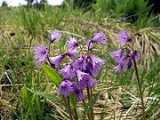
Soldanella
Encyclopedia
- "Snowbell" redirects here. The distantly related genus StyraxStyraxStyrax is a genus of about 130 species of large shrubs or small trees in the family Styracaceae, mostly native to warm temperate to tropical regions of the Northern Hemisphere, with the majority in eastern and southeastern Asia, but also crossing the equator in South America...
is sometimes also called thus.
The genus Soldanella, commonly known in English
English language
English is a West Germanic language that arose in the Anglo-Saxon kingdoms of England and spread into what was to become south-east Scotland under the influence of the Anglian medieval kingdom of Northumbria...
as snowbell, includes about 15 species
Species
In biology, a species is one of the basic units of biological classification and a taxonomic rank. A species is often defined as a group of organisms capable of interbreeding and producing fertile offspring. While in many cases this definition is adequate, more precise or differing measures are...
in the flowering plant
Flowering plant
The flowering plants , also known as Angiospermae or Magnoliophyta, are the most diverse group of land plants. Angiosperms are seed-producing plants like the gymnosperms and can be distinguished from the gymnosperms by a series of synapomorphies...
family Primulaceae
Primulaceae
Primulaceae is a family of flowering plants with about 24 genera, including some favorite garden plants and wildflowers. It is also known as the primrose family.- Genera :...
, native to Europe
Europe
Europe is, by convention, one of the world's seven continents. Comprising the westernmost peninsula of Eurasia, Europe is generally 'divided' from Asia to its east by the watershed divides of the Ural and Caucasus Mountains, the Ural River, the Caspian and Black Seas, and the waterways connecting...
an mountain
Mountain
Image:Himalaya_annotated.jpg|thumb|right|The Himalayan mountain range with Mount Everestrect 58 14 160 49 Chomo Lonzorect 200 28 335 52 Makalurect 378 24 566 45 Mount Everestrect 188 581 920 656 Tibetan Plateaurect 250 406 340 427 Rong River...
s, from the Pyrenees
Pyrenees
The Pyrenees is a range of mountains in southwest Europe that forms a natural border between France and Spain...
, the Apennines
Apennine mountains
The Apennines or Apennine Mountains or Greek oros but just as often used alone as a noun. The ancient Greeks and Romans typically but not always used "mountain" in the singular to mean one or a range; thus, "the Apennine mountain" refers to the entire chain and is translated "the Apennine...
, the Alps
Alps
The Alps is one of the great mountain range systems of Europe, stretching from Austria and Slovenia in the east through Italy, Switzerland, Liechtenstein and Germany to France in the west....
, the Carpathians
Carpathian Mountains
The Carpathian Mountains or Carpathians are a range of mountains forming an arc roughly long across Central and Eastern Europe, making them the second-longest mountain range in Europe...
and the Balkans
Balkans
The Balkans is a geopolitical and cultural region of southeastern Europe...
. They grow in woods, damp pastures and rocky landscapes from 500-3,000 m above sea level, usually in hollows which hold snow
Snow
Snow is a form of precipitation within the Earth's atmosphere in the form of crystalline water ice, consisting of a multitude of snowflakes that fall from clouds. Since snow is composed of small ice particles, it is a granular material. It has an open and therefore soft structure, unless packed by...
long into the summer. They have been named by gardener and horticulturalist Christine Walkden
Christine Walkden
Christine Helen Walkden is a British television presenter and gardener, best known for her appearances on gardening programmes and The One Show...
as her favourite plant.
Appearance
The plant typically has a basal rosette of simple, orbicular leavesLeaf
A leaf is an organ of a vascular plant, as defined in botanical terms, and in particular in plant morphology. Foliage is a mass noun that refers to leaves as a feature of plants....
1–5 cm wide, with the flower stalks arising from the centre of the rosette, each stalk bearing 1-6 white to violet flower
Flower
A flower, sometimes known as a bloom or blossom, is the reproductive structure found in flowering plants . The biological function of a flower is to effect reproduction, usually by providing a mechanism for the union of sperm with eggs...
s.
The species are similar to each other and it is nearly impossible to identify images. Subtle differences are observable using a magnifying glass.
The species can be lumped in groups of similar appearance.
Large-sized plants
1. S. villosa occurring in Basque Lands at low elevations has large papery leaves and about 1 mm glandular hairs on petioles.
Medium-sized plants
2. S. alpina including S. occidentalis and S. pyrolaefolia occurring in the Alps and Southern European mountains has sitting glands on petioles, scapes and pedicels.
3. S. carpatica occurring in the Western Carpathians in Slovakia and Poland has sitting glands on petioles but short glandular hairs on pedicels.
4. S. marmarossiensis including S. rugosa occurring in the North-Eastern Carpatians in the Ukraine and Romania has short glandular hairs on petioles and pedicels and narrowly crateriform corolla.
5. S. angusta, S. calabrella, S. chrysosticta including S. cyanaster, S. hungarica, S. major, S. montana, S. oreodoxa, S. pindicola including S. dimoniei and S. macedonica, S. pseudomontana, S. rhodopaea, S. tatricola all having broadly crateriform corolla mutually differ in the length and shape of cells forming short glandular hairs on petioles and pedicells.
Small-sized plants
6. S. alpicola occurring in the Alps, S. pusilla occurring in the Southern Carpathians and S. pirinica occurring in Bulgaria are characterized by the top position of the bract and sitting glands. Often encountered hybrid S. alpina × S. alpicola has laterally positioned bract.
7. S. austriaca and S. minima occurring in the Alps and Apennines are characterized by short glandular hairs and laterally positioned bract.

